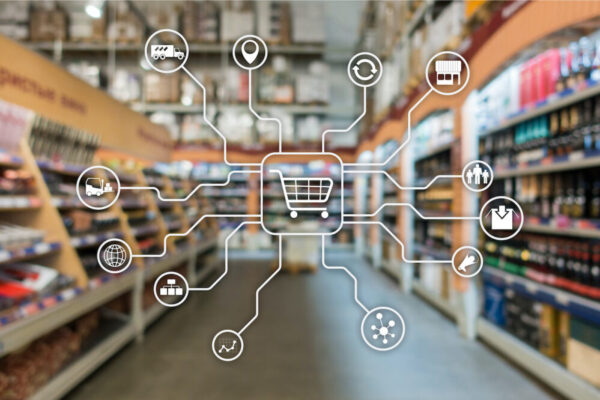The rise of online shopping coupled with a worldwide pandemic makes for trying times in the retail industry, especially for independents. In one week, Boohoo added 772 new garments to its site — how does an independent business compete with this output? The good news is their consumer experience is not perfect.
Not everyone wants to trawl through pages and pages of clothing to find what they’re looking for. While digital retailers like Boohoo and ASOS can’t be fought blow for blow in product quantity, their business model allows for a different kind of retailer to bloom — retailers that do the customers’ legwork for them.
Whether it be tech innovations, sustainability choices, high-quality products, or simply smaller, more streamlined web pages, there are many ways SME retailers can stand apart from their giant competitors and offer something different to consumers.
Improve the selection process

Digital retailers are currently engaged in a desperate scramble to see who can shorten the selection process through a variety of means, chief among which is the custom, personalised wardrobe that suggests clothes you might like based on your previous choices. Zalando employs an astonishing 600 people just to develop the artificial intelligence technology that offers these personalised suggestions.
And for the most part, it’s working. Zalando reports that its outfit recommendations are driving 40% larger basket sizes and higher conversion rates. With that said, the technology is still far from perfect. Zalando’s algorithm requires data from its customers before it can start making recommendations, so first-time visitors are greeted with the same intimidating mass of options as before.
Short of hiring 601 AI experts, independent retailers have no hope of competing on the same field of algorithm development, but thankfully, they have their own set of advantages. By the very nature of being an independent retailer, product selection is of course much simpler. The limited number of products per page makes for a wholly different consumer experience.
Rather than spending time navigating advanced search functions to filter down choices or absent-mindedly scrolling through maxed-out pages, users are more likely to be alert and attentive, looking at each of the products as they scroll. Retailers can amplify this by using high-resolution, larger images with fewer items per row to afford a more detailed inspection.
With consistently high product quality, consumers can enjoy a much higher ‘hit ratio’ than they would with e-commerce giants — a significant point in the favour of SME retailers. But this still isn’t customised. The real question is whether or not retailers can offer smart, custom suggestions without fancy AI and algorithms.
Perhaps some retailers could partner up with platforms like Pinterest that log users’ visual tastes and recommends new pictures based on past likes. Or, more realistically, retailers could deliberately curate outfits for seasons, events, types of weather or recent trends. Ultimately, what a consumer wants from an independent retailer is refined, selective, good taste – quality over quantity – and it is this feature those independent retailers need to display.
Beyond the clothes — brand loyalty

Another piece of good news for independent retailers is that they get to cash a cheque that e-giants struggle to get a grip on — brand loyalty. If Zalando successfully recommends an outfit that one user loves, the user will be impressed with the platform but will still recognize that the recommendation was AI-generated.
The user could be just as likely to visit ASOS and check out what recommendations their AI has. A consumer that loves an outfit curated by an independent retailer, on the other hand, will directly attribute this ‘good taste’ to the retailer itself. The consumer will form a strong, positive connection with the brand, and is likely to subscribe to a newsletter or return to the website for future purchases.
‘Brand loyalty is a strange term to use in a capitalist society, but it’s really the intersection between commercial retail and human, social relations. Smaller businesses are more human because they are run and managed by a small number of people whose personalities are infused within the business.
Big corporations become amorphous entities, platforms that provide a service without any real, human contact. ‘Brand loyalty should really be ‘brand appreciation’, and it’s something that successful SME retailers actively benefit from.
Buzzword of the century — Sustainability

On the tip of every corporation and politician’s tongue right now, sustainability is only becoming more and more relevant in 2023. A 2019 Forbes report found that Gen Z are willing to spend an additional 10% on products with sustainability credentials. Given that this demographic will soon be set to enter the workforce, it’s safe to say that there is substantial room in the market for sustainability-centric retailers.
According to Koreti ‘We may only be seeing the beginning of the sustainability movement. As the socially active younger generation comes of age, sustainability may be the single most important factor in their purchasing decisions. That fact alone will have a huge impact on the retail industry.’
Sourcing from high-quality, sustainable materials can easily grow into a brand image that consumers are drawn to, especially when contrasted against the wholly unsustainable brand image of most retail giants. Of course, any retailer boasting sustainability claims had better be able to back those up with tangible facts, but filling this niche in the retail market ensures viability versus the myriad companies (generally larger) that, from an eco-perspective, fall short.
The retail industry, as with many older industries, is struggling to adapt to these new times. The pandemic is hard enough to handle, but to successfully break out into the online shopping scene and gain visibility is incredibly difficult without time, diligence and expertise.
Many would say that the retail landscape is looking bleak at the moment, but in reality, there is a strong potential future for independent retailers beyond the pandemic. Those that do survive this next year will have to forge durable customer ties to prevent losing business to convenience e-giants, but those that do stand in a solid position to succeed in the coming years.



















